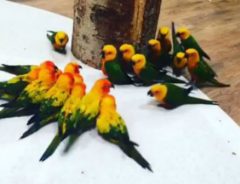- Source:
- h/t: A Set of Nameless Paints Wants to Change the Way Kids Learn About Color / @orangeflower08 / kokuyo.co.jp
Related Article
-

Give yourself a shaving impact with Neon Genesis Evangelion razors by Schick
-

Birds Clash In A Squeaky Rap Battle…Or Chirpy Political Debate
-

Japan Releases Cafe Latte Flavored Water
-

3-D art bubbly scarf-wearing shiba inu glasses are your cutest drinking buddies
-

Japanese maker releases low calorie and protein packed “Karaage without sin”
-

Impress Your Friends With This Surprisingly Easy Rilakkuma Omurice Recipe



Japanese designers are trying to create a new bare bones approach to learning about colors at young ages--by taking out the names and labels.
Called "Nameless Paint" (to be released in October 2015), the concept revolves around labeless tubes of paint, where instead of names, the combination and amount of primary colors used to make the featured color of the paint in the tube are provided. The design partners, Ima Moteki, which consists of Yusuke Imai and Ayami Moteki, describe that product as "a paint that allows you to forget assigned labels and enjoy painting with free expression and thinking...by not assigning names to the colors we want to expand the definition of what a color can be, and the various shades they can create by mixing them."
Source: spoontamago
Source: spoontamago
Each tube comes nameless, with a colored circle equation displaying what colors are used to produce the color inside the tube. The size of the circle displayed indicates the amount of paint used in the mix. Without names to guide them, kids are encouraged to be more intuitive in the way they learn about colors and ask questions about the colors they see around them. Perhaps with this open approach to cognitive learning a child can be more understanding at a young age about the ambiguity of colors and a need to restrict things to named categories they may not necessarily belong in. On the flip side, however, this could theoretically bring up problems in verbal communication with color identification being tied to the tubes. However it turns out, it's a cool concept that lets kids be a bit more free-flowing with the way they learn in their most formulative years.
Source: spoontamago
Source: spoontamago
Source: spoontamago